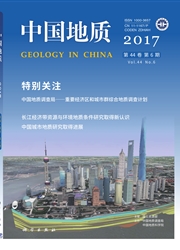

 中文摘要:
中文摘要:
萨嘎蛇绿岩位于雅鲁藏布江缝合带(YZSZ)的中段,主要由地幔橄榄岩、辉长岩、辉绿岩和玄武岩组成。在萨嘎蛇绿岩南侧分布一条熔岩带,与萨嘎蛇绿岩呈断层接触。该熔岩带呈北西西向展布,宽约1~3 km,长约150km。熔岩呈块状构造,气孔和杏仁状构造发育,斑状结构,基质为间粒间隐结构。斑晶主要为斜长石(钠长石化,含量15%~20%),及少量单斜辉石(约5%),单斜辉石(Wo=44~48,En=40~45,Fs=10~12)为含钛透辉石(Ti O2=1.46%)。根据硅碱图(TAS)分类,该套熔岩属于碱性玄武岩类,整体表现为高钛、高铝和高钾,富集Rb、Ba、Th等大离子亲石元素和Zr、Hf等高场强元素,轻重稀土强烈分馏,(Ce/Yb)N=7.30~14.18,平均值为11。萨嘎玄武岩的地球化学特征与大陆裂谷火山岩一致,可能形成于板内裂谷环境。本研究表明,萨嘎碱性玄武岩的地幔源区具有石榴子石残余,早期经历了橄榄石、单斜辉石等镁铁矿物的分离结晶。锆石U-Pb定年结果表明萨嘎碱性玄武岩中锆石年龄较分散,产出的最年轻的一组锆石平均年龄为(54.2±1.4)Ma,它们的εHf(t)介于-11-+1.7之间,具有中元古代的Hf同位素二阶段模式年龄,为壳源的捕获锆石,表明该套碱性玄武岩形成时代不早于始新世早期。
 英文摘要:
英文摘要:
Located in the central part of Yarlung Zangbo Suture Zone(YZSZ), the Saga ophiolite is mainly composed of peridotites,gabbro, diabase and lava. This paper reports a suite of alkaline basalts to the south of the Saga ophiolite, which extends in NWW direction and crops out 1~3km in width. This suite of basaltic lavas has vesicular/ amygdaloid structure and porphyric texture with phenocrysts of plagioclase(15 modal %- 20 modal.% in content) and clinopyroxene(~5 modal % in content). The plagioclase is albite and the clinopyroxene is titaniferous diopside(Ti O2=1.46 wt.%). Based on the composition and TAS diagram, the authors hold that the lava belongs to alkaline basalt. The lava shows the characteristics of low Si O2, high Ti O2,K2 O and Al2O3 content as well as enrichment of large ion lithophile elements( LILE)(Rb, Ba, Th) and high field strength elements( HFSE)( Zr, Hf, Nb, Ta). The rare earth elements(REE) content of the basalt is higher( ∑ REE=266.93 × 10- 6), with a strong fractionation between LREE and HREE(( Ce/Yb)N= 7.30-14.18). The chemical characteristics are similar to features of continental rift volcanic rocks. This study shows that garnets exist as residual minerals in the source. In addition, at the early stage of magmatism, there existed crystallization fractionation of olivine, clinopyroxene and other mafic minerals. U-Pb dating of zircons by LA-ICP-MS yielded a wide range of ages. The youngest group has average age of(54.2±1.4)Ma,with εHf(t)being-11-+1.7, and has the Mesoproterozoic two-stage model age, indicating that these zircons were captured from the crust and the lava had not formed until early Eocene.
 同期刊论文项目
同期刊论文项目
 同项目期刊论文
同项目期刊论文
 期刊信息
期刊信息
